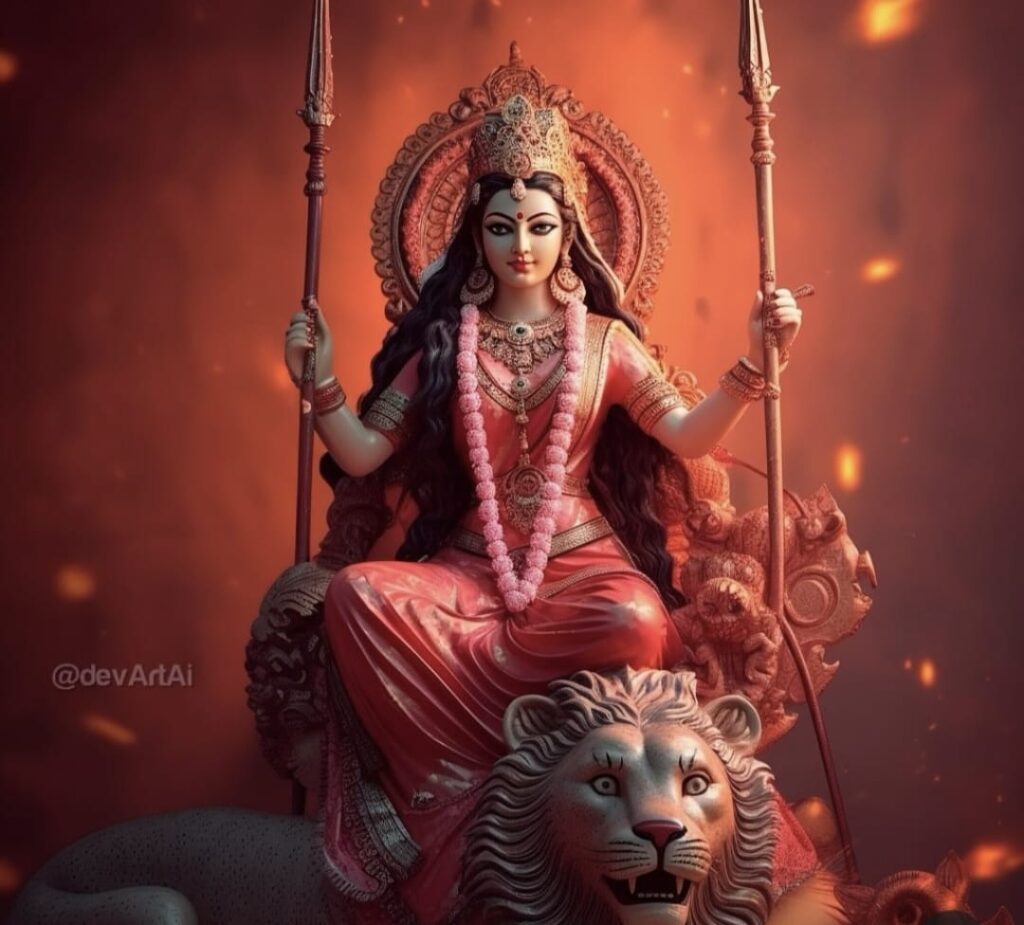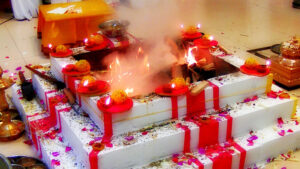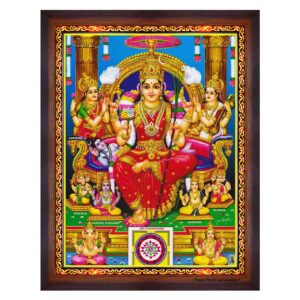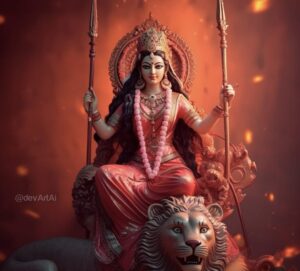Goddess Kushmanda is the fourth form of Goddess Durga, revered on the fourth day of Navratri. Her name, “Ku-shm-anda,” is derived from three words: “Ku” (little), “Ushma” (warmth or energy) and “Anda” (cosmic egg). Together, they symbolize her role as the creator of the universe, infusing it with energy and warmth.
According to Hindu mythology, before the existence of the universe, there was complete darkness and nothingness. Goddess Kushmanda created the universe with her divine smile, dispelling the darkness. Her radiant smile generated energy, which eventually led to the formation of planets, stars and life. She is often depicted as sitting on a tiger, symbolizing courage and fearlessness.

The tale of Goddess Kushmanda shines as brilliantly as the sun itself. She’s not just a deity; she’s the very energy at the heart of the Sun God, the source of life’s sustaining power, and the cosmic balancer. Kushmanda is synonymous with Shakti, the divine feminine force that weaves through the fabric of the universe.
Two formidable asuras, Mali and Sumali, sons of the mighty asura warrior Sukesh, engage in an intense meditation. Their devotion is so profound that their bodies emit an otherworldly glow, surrounded by positive ions. This spectacular display captures the curiosity of none other than Suryadev, the Sun God. You see, celestial beings usually stay in their orbits, but Suryadev’s inquisitiveness got the best of him, compelling him to venture closer to the radiant brothers.
As he approached Mali and Sumali, their fervent energy turned them into ashes. Lord Shiva, upon witnessing this event, hurled his trident, causing Suryadev to plummet, and the universe to descend into darkness. This darkness was so profound that it threw off the balance of celestial bodies and disrupted the very force of gravity.
Imagine Rishi Kashyapa, the father of the gods, heartbroken by Suryadev’s condition. In his sorrow, he cursed Lord Shiva, foretelling the loss of his own child. Desperate to rectify this cosmic imbalance, Shiva turned to Parvati, reminding her of her role as the source of all energies and the mother of the universe. He implored her to set things right.
Moved by Shiva’s plea, Parvati created a radiant spherical body of fire and light within the cosmos, now recognized as the Sun. From this fiery sphere emerged Parvati herself, adorned with timeless beauty and grace.
Sukesh, Mali, and Rishi Kashyapa soon arrived on the scene. Sukesh wept, but Rishi Kashyap seethed with anger. Seeking a solution, Rishi Kashyap and Devi Aditi visited Parvati. She instructed them to fill one pot with their own blood. With mystical prowess, Rishi Kashyap filled the pot with their combined blood. Simultaneously, the other pot brimmed with divine nectar, Amrit. Parvati directed Rishi Kashyap to pour this sacred blend into Suryadev’s mouth, resurrecting him.
In gratitude, Rishi Kashyap prophesied that Parvati would give birth to a child destined to become the greatest deity in the entire universe. Sukesh and his wife Devavati also came to Devi Parvati, bearing the ashes of Mali and Sumali. In response, Parvati gifted Devavati an egg in her womb, from which were born demon progeny. Yet, Parvati’s intentions were pure, earning her the name “Kushmanda.”
Goddess Kushmanda, residing at the core of the Sun, embodies unmatched strength and her radiance infuses the Sun with its luminosity. She’s the guiding force behind Surya, the Sun God, ensuring the brilliance of the cosmos.
Appearance and Iconography
Goddess Kushmanda is depicted with eight arms, holding various objects and weapons symbolizing her divine powers. She holds a kamandalu (water pot), a bow, an arrow, a lotus, a mala (rosary), a chakra (discus), a gada (mace), and a sword in her hands. Her radiant, golden aura is believed to dispel darkness and sorrow from her devotees’ lives.
Method of Worship
Devotees worship Goddess Kushmanda with great reverence and devotion during Navratri. To seek her blessings, you can follow this simple worship method:
- Begin by purifying your mind and body through a cleansing bath.
- Set up an idol or image of Goddess Kushmanda on an altar.
- Light a lamp or incense to create an auspicious atmosphere.
- Offer flowers, fruits, and sweets to the Goddess.
- Recite prayers, mantras, and bhajans dedicated to Goddess Kushmanda.
- Conclude the worship by seeking her blessings for courage, energy, and the removal of obstacles from your life.
Mantras to Chant with Translations
- Mantra:
- Sanskrit: ॐ देवी कूष्माण्डायै नमः॥
- Transliteration: Om Devi Kushmandayai Namah॥
- Translation: I bow to Goddess Kushmanda.
- Mantra:
- Sanskrit: सुरासम्पूर्णकलशं रुधिराप्लुतमेव च।
- Transliteration: Surasampurnakalasham rudhiraplutameva cha।
- Translation: You are the one who holds a pot filled with divine nectar and rides a lion.
Astrological Connection
Goddess Kushmanda is associated with the planet Sun. Her radiance and energy represent the qualities of the Sun, which provides light and vitality to the world. Worshipping Goddess Kushmanda is believed to bring success and harmony in one’s life by invoking the blessings of the Sun.
Significance
Goddess Kushmanda is worshipped for her role as the creator of the universe, the source of energy, and the dispeller of darkness. Her blessings are sought to overcome lethargy, attain strength and achieve success in endeavors. She symbolizes the nurturing and life-sustaining aspects of the divine feminine energy, and her worship is a way to tap into these qualities for personal and spiritual growth.
Author,
Sivalenka Neeraja





